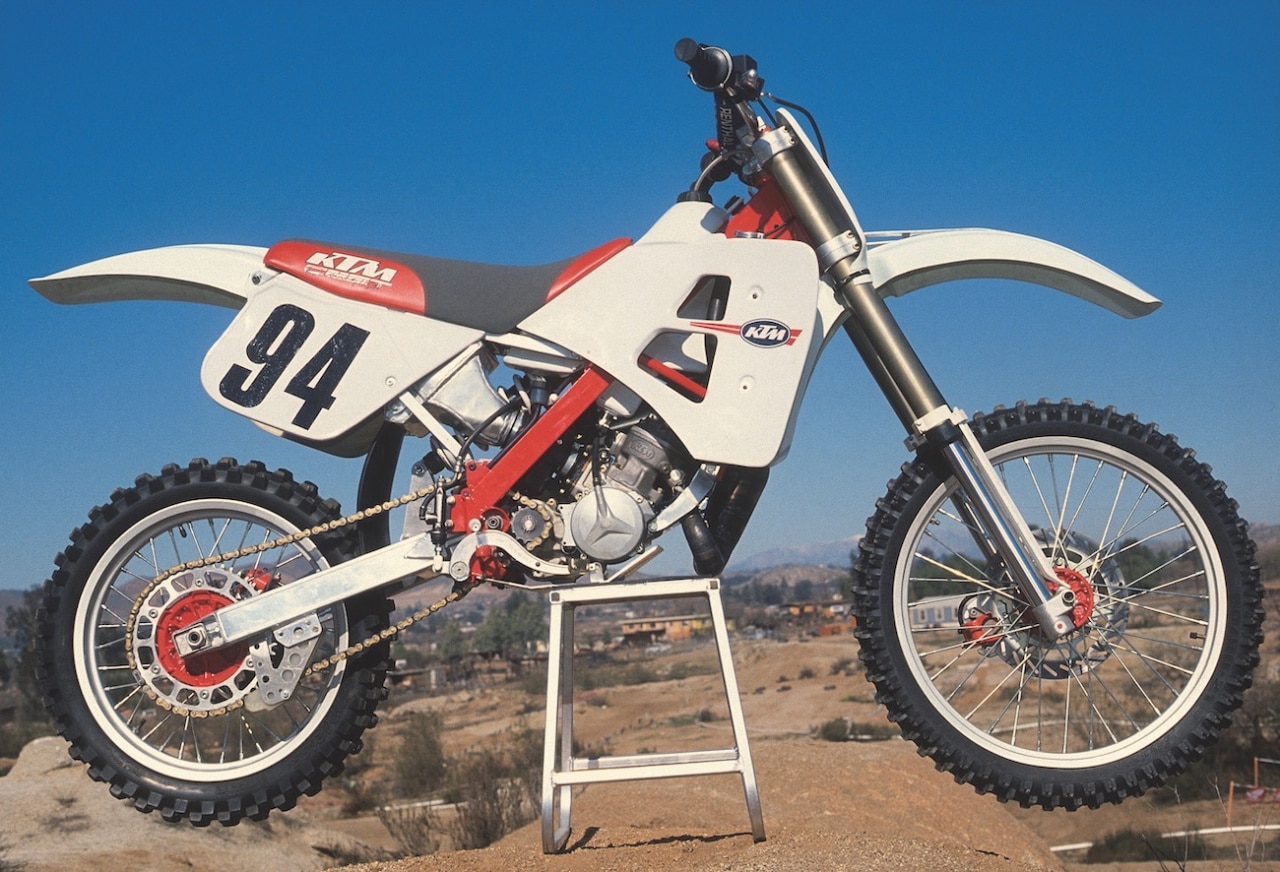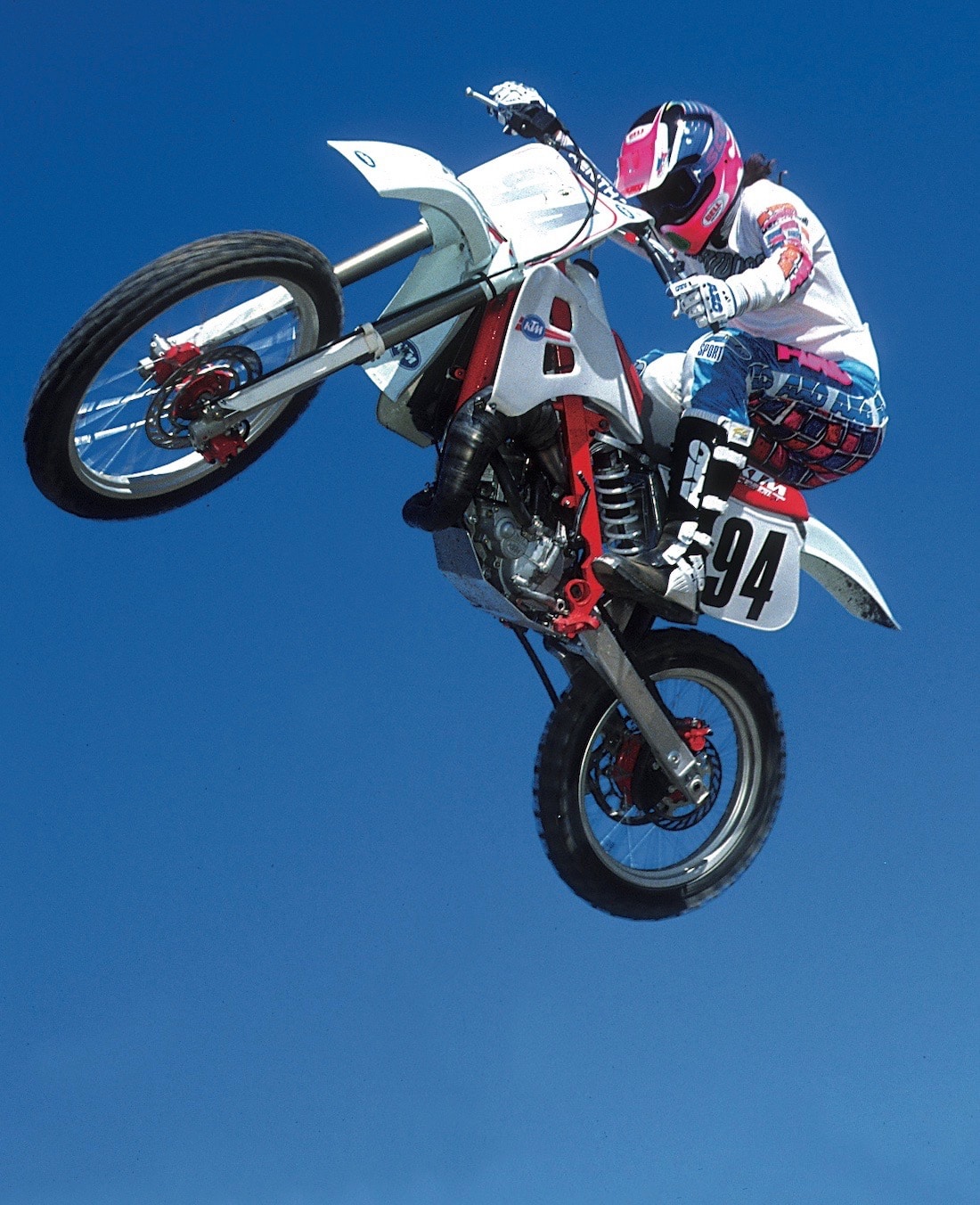TWO-STROKE TUESDAY: HORST LEITNER’S RADICAL AMP RESEARCH KTM 125SX PROTOTYPE
 Built under commission from KTM as the “125 of the future,” Horst’s 1990 AMP Research 125 weighed under 190 pounds thanks to its minimalistic chromoly parallax frame design
Built under commission from KTM as the “125 of the future,” Horst’s 1990 AMP Research 125 weighed under 190 pounds thanks to its minimalistic chromoly parallax frame design
At the 1989 Milan Motorcycle show in Italy, then KTM owners (Git Trust) approached AMP Research’s Horst Leitner to build them a prototype of the 125 two-stroke of the future. Horst was one of the most successful independent motorcycle designer of the 1980s and 1990s. He founded ATK Motorcycles, which built the 406 two-stroke and 605 four-stroke, also the Scott/PBH for England and the Avenger for the USA. The carrot at the end of the stick wasn’t the money that KTM agreed to pay Horst for the one-off machine, but the chance to design future KTM models.
Why was KTM’s management going outside of their own corporation to hire an independent motorcycle designer? After all, they had a bevy of designers and engineers in their employ in Mattighofen. The new investors suspected that KTM’s in-house design staff had failed to deliver stellar products in the past and didn’t want to trust their sizable investment in the company to the same men who had failed to deliver for the old owners. They wanted to bring in a “Pro from Dover.” They chose Horst Leitner as a way of showing the existing KTM designers that their jobs weren’t safe. The new owners reasoned that outside competition, especially since he was from a fellow Austrian, would wake up their Austrian design team. The decision to ask Horst Leitner to design a totally new bike had more to do with bureaucratic politics than a search for creativity.
 Before the AMP Research 125 KTM project was started, Horst built a full-size mock-up—that included most of the strategic points and cardboard radiator wings.
Before the AMP Research 125 KTM project was started, Horst built a full-size mock-up—that included most of the strategic points and cardboard radiator wings.
KTM told Horst that he had to use as many existing KTM 125SX components as possible, and that included the forks, wheels, swingarm, brakes, ignition and complete KTM 125 two-stroke engine. These were nonnegotiable parts, but everything else was fair game. And, Horst played fast and loose with the rules as laid out.
 The AMP Research frame used three chromoly tubes, two rectangular and one round) to comprise 95% of the frame. It used one long radiator on the right side and the pipe went up and under the left side radiator shroud.
The AMP Research frame used three chromoly tubes, two rectangular and one round) to comprise 95% of the frame. It used one long radiator on the right side and the pipe went up and under the left side radiator shroud.
When the AMP Research KTM 125 was completed, it was almost space age for the time. It was incredibly small. Not small as in petite, but every aspect of the AMP Research bike was greatly reduced in size. The frame was something that Horst called a “parallax” frame. It was made up of only two main tubes, plus the stock KTM head/down tube. The two backbone tubes were large-diameter, rectangular, chromoly spars that were straight and true — sans any bends. The KTM 125 engine was used as a true stressed member of the overall layout. There were no down tubes on Horst’s frame, and the footpegs and swingarm pivots mounted to uprights that also served to hold a CNC-machined aluminum bridge that tied the bottom of the frame together. It was simple in design but intricate in terms of engineering savvy. To remove the complete engine from the AMP Research 125, all a mechanic had to do was pull the swingarm pivot bolt and front motor-mount bolts. Gravity took care of the rest.
 The rear suspension was the first-ever no-link, single-sided, laid-down-shock motocross suspension ever designed. The rear suspension got its rising rate from the position of the shock in relationship to the swingarm pivot and top shock mount. Note the silencer exiting behind the engine
The rear suspension was the first-ever no-link, single-sided, laid-down-shock motocross suspension ever designed. The rear suspension got its rising rate from the position of the shock in relationship to the swingarm pivot and top shock mount. Note the silencer exiting behind the engine
This unique chromoly frame came seven years before the era of twin-spar aluminum frames. Ahead of its time, the parallax frame was the most visible part of the 125 prototype but not the most inventive. It was feather light, extremely narrow and like no other bike made 34 years ago.
 The silencer did not extend out the back of the AMP Research 125, but instead was routed downwards through the swingarm.
The silencer did not extend out the back of the AMP Research 125, but instead was routed downwards through the swingarm.
Before the AMP Reaserch 125 was shipped to Austrian, Horst took the precaution of having MXA race it and photograph to insure a record of how the bike performed before being handed over to KTM. The next day the AMP Research KTM 125 was shipped to Austria for R&D testing in 1990. But, it never really stood a chance of going into production. Why not? In one of those catch-22s that can only happen in the corporate world, KTM’s management assigned their in-house design department—the one they were trying to embarrass—to evaluate the prototype. This fail-safe was all the threatened engineers needed to ensure job security.
 The 1990 AMP Research 125 in flight.
The 1990 AMP Research 125 in flight.
They nitpicked the AMP Research prototype to death and even took the time to photograph every interference fit, crack in the aluminum airbox mount and even a head tube crack (even though it was their head tube). In the end, the AMP Research prototype was rolled into a dark warehouse and disappeared forever. Until 30 years later.
AND NOW FOR THE REST OF THE STORY…FAST FORWARD 30 YEARS
 This is the AMP Research prototype as it looks today. Although a few parts are missing, there is nothing major. In truth, it looks as though it has not been ridden more than one hour in the last 34 years. Even the original numbers are still on the front plate.
This is the AMP Research prototype as it looks today. Although a few parts are missing, there is nothing major. In truth, it looks as though it has not been ridden more than one hour in the last 34 years. Even the original numbers are still on the front plate.
After 30 years of silence, Harry Leitner, son of ATK and AMP Research founder Horst Leitner, got a Facebook message from an Austrian motorcycle racer named Hanson Schruf asking about a bike he had—that Hanson, who worked as a test rider at KTM found abandoned in a warehouse. He thought it was the special one-off 1990 KTM prototype and sent photos to Harry. Harry recognized the bike immediately as the special project that his father Horst had built in AMP Research’s Laguna Beach facility under contract to KTM back in 1989.
 Although the cone pipe is a little corroded, the fiberglass fuel tank, original seat and all the plastic remain intact. Those are even the original KTM radiator wing decals that were put on before the bike was shipped from Laguna Beach to Austria in 1990.
Although the cone pipe is a little corroded, the fiberglass fuel tank, original seat and all the plastic remain intact. Those are even the original KTM radiator wing decals that were put on before the bike was shipped from Laguna Beach to Austria in 1990.
Horst designed and built the bike because KTM’s then-owners wanted the “125 of the future” to show their engineers about the possibilities in motorcycle design. When Horst was finished building the bike, Horst told MXA that they could could shake it down before it was crated up and shipped to Austria. In hindsight it was a good thing that Horst gave the bike to MXA before he gave it to KTM, because once the bike got to Austria it was never seen again—until Hanson Schruff sent these photos to Harry Leitner.
 Austrian racer Hanson Schruf ended up with the prototype 30 years after it disappeared and contacted Horst Leitner’s eldest son Harry to find out more about it. That was the first time the Leitner’s had heard anything about or seen the bike since they built it.
Austrian racer Hanson Schruf ended up with the prototype 30 years after it disappeared and contacted Horst Leitner’s eldest son Harry to find out more about it. That was the first time the Leitner’s had heard anything about or seen the bike since they built it.
 The AMP prototype bike was largely intact. The paint on the frame showed wear marks on the trailing edge behind the footpegs. The pipe had rusted, but there were no wear marks on it. Even the fiberglass radiator wings and gas tank were barely scuffed. The 34 year-old seat looked like it had never been ridden. Makes you wonder how much time KTM’s 1990 engineers put into actually testing the bike.
The AMP prototype bike was largely intact. The paint on the frame showed wear marks on the trailing edge behind the footpegs. The pipe had rusted, but there were no wear marks on it. Even the fiberglass radiator wings and gas tank were barely scuffed. The 34 year-old seat looked like it had never been ridden. Makes you wonder how much time KTM’s 1990 engineers put into actually testing the bike.






Comments are closed.